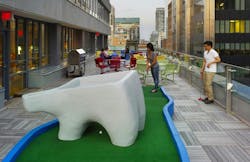Hospitality at the workplace: 5 ways hotels are transforming the office
During the past five years, the worlds of hospitality and corporate real estate have undergone an incredible transformation. The traditional approach toward real estate asset management has shifted to a focus on offerings that accommodate mobility, changing demographics and technology.
In the past, hotels approached their planning and visioning process by looking at brand standards and identifying a suitable theme based on the destination’s local culture. Similarly, companies relied on space allocation metrics to identify the amount of support spaces needed per employee and to balance the number of offices and workstations.
Recently, however, clients from both sectors are looking for innovative ways to respond to the demands of the new economy. Randa Tukan and I had the opportunity to review recent trends in each industry during a session held at the CoreNet 2014 North American Summit, which took place in Washington, DC, Oct. 26-29. In this session, we reviewed several trends that are changing space design and utilization in the hospitality and corporate real estate industries. We classified these trends in the following five categories:
1. Arrival experience. Hotel lobbies are downsizing and taking a multi-functional approach toward their arrival experiences, often branching into bars, lounges or coffee shops. These spaces offer a backdrop to mingle and connect, while also helping increase the amount of revenue-generating spaces. Arriving at a workplace is one of the most important experiences for employees, visiting staff and guests. Progressive companies allow employees to check-in remotely and reserve space that meets their work needs. They offer concierges to support visiting staff and enhance the day-to-day activities of their local workforce. Lobbies in these companies resemble a coffee shop or hotel lounge and tend to have a more homey feeling.
2. Social hubs. With increased business travel and the fading line between personal and professional time that mobility has brought to our lives, it is natural to see a blurring of business with leisure travel. The increased trend of smaller guest room footprints and the need to reduce non-revenue generating spaces helped support a proliferation of multi-functional spaces to eat, drink, meet, connect and work in business hotels. Space optimization tactics are also common among companies in the new economy. Reduced workstation sizes are also driving people to social hubs. Social hubs, similar to those we often see at hotels or airports, are becoming part of activity-based neighborhoods across geographies. Social hubs are flexible, centrally-located, often multi-purpose spaces that accommodate today’s technology and support face-to-face collaboration.
3. Indoor/outdoor spaces. Hotels are opening up and connecting to the city or natural features in the local context rather than being isolated indoors, extending the lobby space to the outdoors and changing its functionality. Indoor/outdoor spaces are morphing from rooftop restaurants and bars to unique gatherings where guests meet, play and connect, especially in urban destinations such as New York City, Washington, DC, and Miami. Companies are also opening up to rooftop terraces and integrating small indoor/outdoor spaces to their work environment.Using social media, HOK’s Leigh Stringer led and conducted a workplace survey involving 3,600 employees. Survey findings reflect that 82 percent of respondents reported experiencing neck, back and shoulder pain, often associated with sitting for long periods of time during the day. The easiest way to prevent most of these common complaints is to promote mobility within your work environment and offer ways for employees to engage in regular light physical activity like walking or a 10 to 15 minute game of ping pong or mini golf. Incorporating small outdoor spaces into corporate environments is an increasing trend among companies concerned about employee well-being.
4. Dining and meeting. Hotel revenues from food and beverage outlets commonly represent 10 to 15 percent of all hotel revenues (excluding conference group booking). Three-meal restaurants are no longer popular among travelers and local residents looking for authentic dining experiences. Smaller and themed restaurants and lounges featuring specialty chefs are much more enticing propositions to hotel operators and patrons. Corporate dining experiences and break rooms at the workplace continue to evolve, yet the undeniable office amenity continues to be the break room or café. Cafés offer alternative locations for informal gatherings and are preferred by millennials due to their similarity with campus cafés. Many companies hire baristas to bring a coffee shop service experience to their workplace and help keep these spaces neat.
5. Personal space. Hotels are increasingly focusing on offering their guests a unique experience during their stays. Today’s hotel rooms are flexible, adaptable and offer privacy, individuality and customization in reduced footprints. Among companies, the continuous reduction in space allocation per employee and increased sharing ratios impact an employee’s ability to be productive at work if space is not adequately designed. The two most common shortcomings of exclusively open-plan environments are lack of spaces to conduct focused work or have a private conversation. The nature of today’s work requires employees to conduct a diversity of tasks within a work day and a single, all-purpose workstation does not offer employees the amenities and space functions needed to support their work patterns. Companies are offering their employees a variety of workstations and spaces to think, create, connect, relax and be productive at work.
About the Author
Eva Garza is a Senior Consultant in HOK's Miami consulting practice, where she provides programming, workplace strategies, and change management advice to HOK clients. Her background in architecture and city planning combined with her expertise in hospitality design and economic research helps her understand high-level real estate strategy as well as detailed workplace strategy issues. In her free time, Garza volunteers as board member at USGBC Miami Center for Schools and helps schools in Miami-Dade achieve sustainable strategies.

